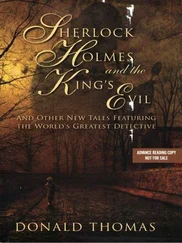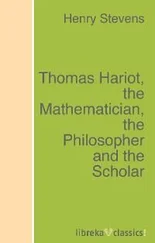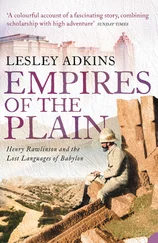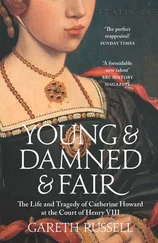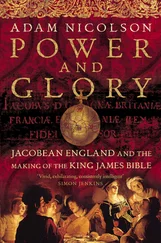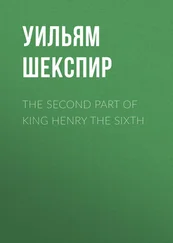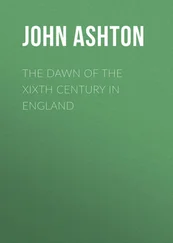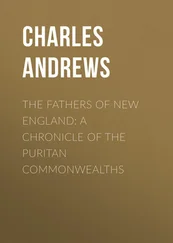The procession came to a halt in front of the house commandeered by the king, and the fifth pageant. Built over the Standard, another of London’s conduits and a notorious place of punishment, the tableau was a stylized heaven in which mellifluous choirs of angels – Cornish’s highly trained child singers – surrounded an enthroned godlike figure dressed entirely in gold. A second character dressed as a bishop, gesturing towards the onlooking Henry VII, compared him with the costumed deity: ‘Right so,’ he declaimed, ‘our sovereign lord the king/ May be resembled to the king celestial/ As well as any prince earthly now living.’ Looking from one to the other, the onlookers must have been struck by the uncanny resemblance: the costumed god of the pageant was made up to look like Henry himself. Under the king’s approving eye, the enthroned actor showered the princess with benedictions, blessing ‘the fruit of your belly’. Kingliness, as embodied by Henry VII, was next to Godliness. 47
At the top of Cheapside, Catherine reached the final pageant. The Little Conduit, in front of the church of St Michael Le Querne, marked the eastern entrance to St Paul’s churchyard. Here, the costumed figure of Honour showed Catherine that she had reached the end of her quest, indicating as he did so two vacant thrones, containing crowns and sceptres, on either side of him, awaiting the happy couple. Receiving gifts of gold and plate from London’s dignitaries, the party then progressed around the streets bounding the churchyard before entering the cathedral where, giving thanks and making offerings, Catherine was blessed by the archbishop of Canterbury. When she emerged, the procession broke up, Catherine and her retinue withdrawing to the bishop of London’s palace on the north side of St Paul’s churchyard. Prince Arthur headed southwest, where the city shelved steeply towards the river in a tangle of backstreets, to his lodgings at the Great Wardrobe, one of the inner-city royal houses. 48Prince Henry, meanwhile, overnighted at the bishop of Durham’s great house on the Strand. The various nobles, servants in tow, retired to their ‘places, lodgings and inns’ scattered throughout the city.
The following day, Saturday, the king received the Spanish ambassadors at Baynard’s Castle, his lavishly rebuilt residence on the Thames, east of Blackfriars. 49With the two princes at his right and left, he listened as the ambassadors itemized the terms of the forthcoming marriage, in particular, the ‘assureness’ of Catherine’s virginity. As the afternoon wore on, Catherine was brought down the hill to Baynard’s Castle for an introduction to Queen Elizabeth, in whose frank brown-eyed gaze, cupid’s-bow mouth and strawberry-blonde hair so characteristic of the Plantagenets Catherine would have immediately seen the resemblance to the boy who had accompanied her through London’s streets the previous day. The queen and young princess immediately clicked. Formalities over, the afternoon dissolved into something altogether more relaxed: conversation flowed, unforced; Elizabeth called for ‘disports’, music and dancing. Late in the evening, ‘with torches lit to a great number’, Catherine was conveyed through the dark, silent streets back up the hill to her lodgings. 50
Mid-morning on Sunday 14 November, the gates of the bishop of London’s palace swung open. Through them, surrounded by a multitude of English and Spanish nobility and with Prince Henry at her side, Catherine emerged, a vision in white satin, Spanish style, along a wide carpet of blue cloth. She wore a hooped, pleated dress and a headdress of white silk bordered by gold and precious stones, her face veiled. Henry VII’s courtiers, meanwhile, had dressed to impress – and impressed the onlookers duly were, London’s merchants pricing everything they saw. The highlight was, predictably enough, Buckingham, whose gown, worth a staggering £1,500 – the cost of all the pageants put together – elicited gasps from the crowd. Trumpet fanfares blared out as the party paraded across the square and up the broad steps to the cathedral’s west door, where the marriage agreements, including the paperwork for the long-negotiated dowry, were exchanged between the English and Spanish dignitaries. 51
Inside, the cathedral’s cavernous interior was transformed, its walls hung with massive tapestries. 52Under its stained-glass rose window, the high altar glinted with gold plate, ornaments and relics encrusted with precious stones. And from the west door, an elevated walkway covered in fine red cloth stretched the length of cathedral, some six hundred feet, to a stage in the round where the ceremony was to take place and which created an effect ‘like unto a mountain’. Together with Queen Elizabeth, his mother Lady Margaret Beaufort and a number of his counsellors and servants, the king, who ‘would make no open show nor appearance that day’, had concealed himself in a closet adjoining the stage, reached by a door specially knocked through for the purpose. Barely visible behind the closet’s latticed windows, they stood ‘secretly to see and apperceive the form and manner of the ministration’. 53
While all eyes were on Catherine and Prince Henry as they paraded slowly down the walkway, Arthur had appeared on the great stage. There, surrounded by the archbishop of Canterbury, eighteen bishops, and attendants dressed in coloured silks and cloth-of-gold, the three children met; Henry gave up the princess to his older brother. As the three-hour-long ceremony drew to a close, the brass section, positioned high above the west door of the cathedral, struck up. The newlyweds, hand in hand, turned to north and south, presenting themselves to the multitudes packed within the cathedral. In the middle of this sea of colour, the two slight figures in white satin saw ‘nothing but faces’.
Following a celebratory mass, and after wine and refreshments had been served, Arthur left as he had arrived: by a side entrance, to greet his new bride at the bishop of London’s palace. Catherine and Prince Henry retraced their steps down the walkway to the west door. Emerging, they were confronted by a green mountain covered in precious metals: the king’s towering monument to Tudor kingship, his contentious Rich Mount. On its summit stood three trees, against which were positioned three kings dressed in armour. In the middle, flanked by the monarchs of France – to which England, of course, still laid claim – and Spain, was King Arthur; from his tree, covered with red roses, sprang a snarling red dragon. As the couple watched, a constant stream of people filed through a gate in the surrounding picket fence to help themselves to the wine that flowed continuously and, it seemed, by magic, from a spring in the mountain’s core. 54
The wedding feast was a suitably sumptuous affair, stretching on until five in the evening and followed by drinking and entertainments. At between seven and eight o’clock Arthur was dragged away from his companions and their ‘goodly disports’ by the earl of Oxford, overseer of the nuptial arrangements. Accompanied to the bedchamber by a group of clergy and courtiers, Arthur found Catherine, surrounded by her attendants, stretched out in the carefully prepared marriage bed. After he had lain down beside her, the pair and the bed were blessed, prayers offered up, censers wafted and holy water liberally sprinkled. Then all withdrew, and the just-married teenagers were left alone. 55
The next day, Monday 15 November, everything was still. The bishop’s palace was ‘under silence’, and Catherine stayed in her chamber together with her ladies and gentlewomen; ‘no access utterly’ was to be had to her and the only person admitted was the earl of Oxford, bearing a loving note from Catherine’s new father-in-law. Earlier Arthur had, apparently, emerged from the bridal suite with a ‘good and sanguine complexion’ and an air of awkward bravado. He called one of his body servants, Anthony Willoughby, the son of Henry VII’s lord steward, to bring him a cup of ale, ‘for I have this night been in the midst of Spain’. 56On Tuesday, the 16th, Henry VII and his two sons, accompanied by five hundred members of the royal household and Catherine’s retinue, processed back to St Paul’s. The new bride was ‘secretly conveyed’ to the closet, high up in the cathedral, from where the king had scrutinized proceedings two days previously. Catherine stood alone, watching as Henry VII gave thanks that ‘this noble and excellent act’ had been brought to its most ‘laudable conclusion’.
Читать дальше


